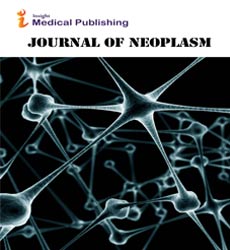Neuroendocrine Carcinoma of the Bosom with a Mucinous
Fishman Zary
Department of Carcinoma, University of Dijon Bourgogne, Dijon Cedex, France
Published Date: 2023-12-18DOI10.36648/2576-3903.8.4.55
Fishman Zary*
Department of Carcinoma, University of Dijon Bourgogne, Dijon Cedex, France
- *Corresponding Author:
- Fishman Zary
Department of Carcinoma,
University of Dijon Bourgogne, Dijon Cedex,
France,
E-mail: Zary_F@gmail.com
Received date: November 16, 2023, Manuscript No. IPJN-23-18311; Editor assigned date: November 20, 2023, PreQC No. IPJN-23-18311 (PQ); Reviewed date: December 04, 2023, QC No. IPJN-23-18311; Revised date: December 11, 2023, Manuscript No. IPJN-23-18311 (R); Published date: December 18, 2023, DOI: 10.36648/2576-3903.8.4.55
Citation: Zary F (2023) Neuroendocrine Carcinoma of the Bosom with a Mucinous. J Neoplasm Vol.8 No.4: 55.
Description
It has been trying to look at the consequences of different investigations because of the shortfall of a normalized meaning of unadulterated mucinous carcinoma of the bosom. An elderly person gives an instance of mucinous bosom carcinoma neuroendocrine separation. The cancer estimated and was fundamentally arranged in the upper external quadrant. Light microscopy revealed a pure mucinous carcinoma with neurosecretory granules, grimelius stain and chromogranin indicating neuroendocrine differentiation. The luminal determined bosom malignant growth cells had dedifferentiated to gain neuroendocrine properties. A strange and over the top tissue development known as a mucinous neoplasm, otherwise called a colloid neoplasm, is joined by mucin, a liquid that occasionally looks like thyroid colloid. Mucin, the principal part of bodily fluid, is delivered by epithelial cells that line specific inside organs and the skin. A mucinous carcinoma is a carcinogenic mucinous neoplasm. For example, roughly 75% of ovarian mucinous growths are harmless, 11% are fringe and 12% are threatening.
Diagnosis of Mucinous Carcinoma
It is obscure whether mucinous development starts in the intraductal carcinoma or later in the obtrusive carcinoma, in spite of the way that Mucinous Carcinoma (MC) of the bosom is remembered to begin from ductal carcinoma. To decide when mucinous development starts, mucin was analyzed by histochemistry, immunohistochemistry and the outcomes demonstrated the way that mucinous development can start in both the normal IDC and the intraductal carcinoma. Microsatellite marker investigation of clonality and histological change exhibited that some MC is gotten from normal IDC. The micropapillary type of the unadulterated type of MC presumably comes from an intraductal carcinoma. A phenomenal bosom disease with a for the most part ideal guess is mucinous or colloid carcinoma. Lymph hubs, lungs and bones are the essential areas of metastases, which normally show up later throughout the illness after essential resection of the cancer has been accounted for as the longest dormancy time frame for the improvement of a far off metastasis. Histology was indistinguishable between the essential cancer and the metastatic injury. This is the second longest timeframe that has been accounted for the improvement of a far off metastasis from an uncommon skin event of mucinous bosom carcinoma. The growth cells coming up short on E-Cadherin protein. Without a histological and immunohistochemical examination, pathologists should keep in mind the possibility of a diagnosis of mucinous carcinoma of the breast with neuroendocrine differentiation.
Frameworks of Neuroendocrine
Mucinous carcinoma of the bosom is extraordinary and represents only 3% of all bosom diseases. Grouping it as an unadulterated or blended type is conceivable. Blended bosom mucinous carcinoma is more forceful than unadulterated mucinous bosom carcinoma. The last option displays much of the time separated neuroendocrine frameworks. A left bosom growth that was developing gradually was introduced by elderly person. A firm, unretractable tumor was discovered during a physical examination in the upper outer quadrant of the left breast. No lymph hubs in the axilla or supraclavicular district were felt. A clear cut, high thickness mass with outlined edges estimating in breadth was identified on left bosom mammography. A biopsy directed by ultrasound was completed the cancers histology uncovered homes and bunches of cells drifting in mucin lakes separated by sensitive stringy septae containing narrow veins. Three of the five patients who had unadulterated mammary mucinous carcinoma had preoperative fine needle desire biopsies and the aftereffects of those biopsies were accessible. As opposed to the mucoid foundation, the immediate smears and cytospin arrangements uncovered durable groups and micropapillae of somewhat pleomorphic cancer cells. There were no veritable growth papillae with fibro vascular center. Also, there were not many secluded growth cells dispersed about. The cell block areas made it simpler to see the pseudoacinar design.

Open Access Journals
- Aquaculture & Veterinary Science
- Chemistry & Chemical Sciences
- Clinical Sciences
- Engineering
- General Science
- Genetics & Molecular Biology
- Health Care & Nursing
- Immunology & Microbiology
- Materials Science
- Mathematics & Physics
- Medical Sciences
- Neurology & Psychiatry
- Oncology & Cancer Science
- Pharmaceutical Sciences
